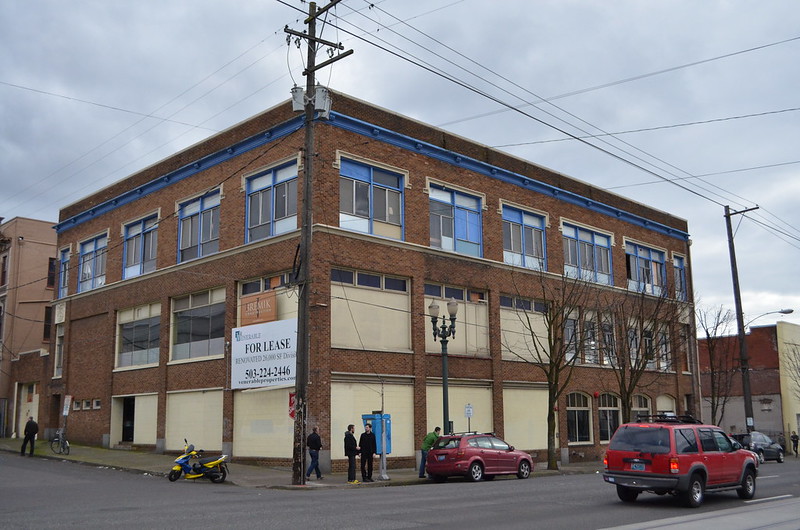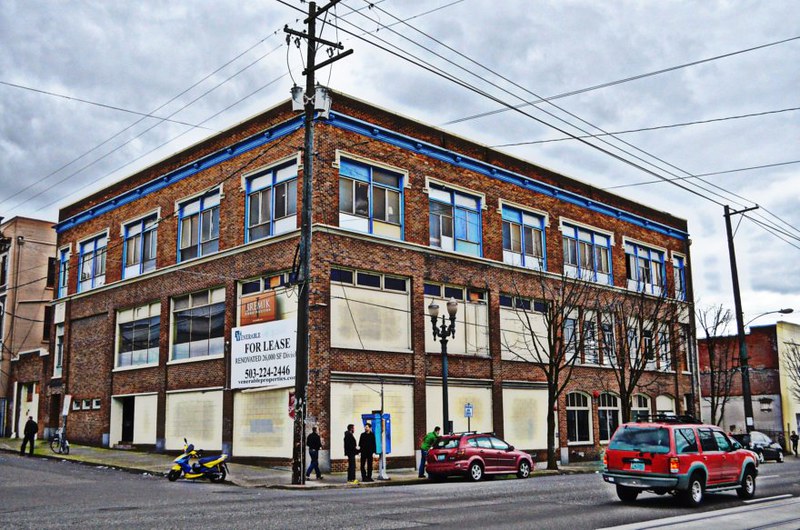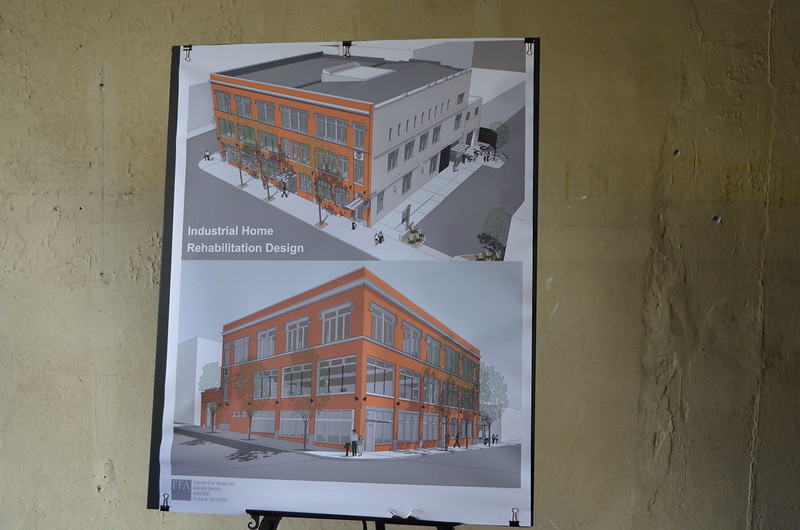Which version pleases you most? I myself cannot make a decision.
 Unaltered
Unaltered
 Picnik
Picnik
 Ipiccy
Ipiccy
 PicMonkey
PicMonkey

A
black and white photo, from the 1930's I think, which was on display at the Hard Hat Tour.
 Fletcher Farr Ayote, Inc.
Fletcher Farr Ayote, Inc.--Industrial Home Rehabilitation Design, also on display at the Hard Hat Tour.
Here's some information about the Salvation Army Industrial Home Building:
Message from the Architectural Heritage Center:
Hard Hat Tour: The Salvation Army’s “Industrial Home” Building, Saturday, March 3, 2012, at 1:00 p.m.
Please Meet at the Industrial Home building – 200 SE Martin Luther King Jr. Blvd. @ SE Ash Street
Sturdy shoes are recommended as this is a construction site.
This is what was written in the AHC (visitahc.org) newsletter:
The Salvation Army is a venerable national institution, serving people in need for more than a century. Throughout the US (and Portland) there are many fine buildings that housed their programs and provided housing. In Portland’s Central Eastside, the Salvation Army’s “Industrial Home” building will be getting a new lease on life, with an adaptive re-use project by Venerable Properties. This 26,000 square foot structure, built in 1893 for a hay and feed business, was acquired by the Salvation Army in 1913. The building was doubled in size in 1930, as part of architect Frederick Manson White’s “face lift” of the building’s entire façade.
The Industrial Home model provided jobs and housing for the homeless under one roof. Workers collected and repaired second-hand goods and a thrift-store sold those goods to the public. The building included a workers dormitory, dining facilities, and a chapel—keeping with the Salvation Army’s focus on the “whole person.”
Several remodels removed or concealed many of the building’s historic features, but that’s about to change. This is your chance to see the transformation in progress, as original materials are uncovered and historic features are wonderfully restored. The afternoon program will cover the project’s vision, building history, and a top to bottom tour. Our own Education Committee Chair, Morgen Young, will place the Industrial Home building in context with Portland’s other Salvation Army facilities.
Fantastic to see the three floors (we didn’t go into the basement) and to hear the history of this building which is actually two buildings and to hear about the plans that Venerable has for a whole lotta square footage.
Blogger is changing in April, which as we all know is just a few days away. I made the MISTAKE of clicking on the announcement earlier this evening, and now I'm STUCK there. Rats. I cannot get my previous method of putting links on my posts to work! I cannot figure out how to use what appears to be a link tool on this new method. RATS.
So, here's what I read on Venerable Properties Web site about the Industrial Home Building:
Venerable’s new development project is the 26,000 sq ft Salvation Army Industrial Home located on Martin Luther King Boulevard and Ash Street. The project will offer approximately 10,000 square ft of ground floor retail/restaurant space to serve the Central Eastside neighborhood. Features will includes large expanses of storefront glass, multiple sidewalk entries, high ceilings, exposed heavy timber structural elements and an oversized skylight for a unique one-story 2,000 square ft addition on Ash Street. The second and third stories will offer 16,000 square ft of office space with huge, new operable windows, high ceilings, exposed structure and light well.
As a bonus, the views of Downtown Portland are outstanding. Finally, Industrial Home will offer parking on a contiguous 9,000 square ft lot accessible by both MLK and Grand.
This redevelopment will be executed by the same team that resurrected White Stag—Venerable Development, Fletcher Farr Ayotte Architects and Bremik Construction. Architectural planning has being and construction is expected to commence in mid-2012.
Brief Building History
The building appears to be one building from the exterior; however, the south half was constructed in 1893 and this structure was then expanded and remodeled in 1930 by architect Frederick Manson White, giving it the uniform appearance it has today.
While the 1893 building first had a hay-and-feed use, it was later owned and used by the Salvation Army as their Industrial Home in 1913. Industrial Homes were more common in major American cities during this time as the Salvation Army was growing and spreading their mission to help the poor. The purpose of the Home was to provide work and shelter for homeless, unemployed men. They would collect, sort and resell recyclable items such as rags and paper and collect, repair and sell second-hand merchandise such as clothes, shoes, furniture and household items.
As was typical for these complexes, Portland’s Industrial Home included a retail thrift store, sorting and repair rooms. The building also contained a dormitory, large washroom, kitchen, dining room and chapel for the workers.
In addition to its significance related to the Salvation Army’s work in Portland, it is notable that this building housed the longest running second-hand shop in the city from 1913 to 2010 and probably also housed Portland’s first organized recycling effort.
 Unaltered
Unaltered
 Picnik
Picnik
 Ipiccy
Ipiccy
 PicMonkey
PicMonkey
 A black and white photo, from the 1930's I think, which was on display at the Hard Hat Tour.
A black and white photo, from the 1930's I think, which was on display at the Hard Hat Tour.
 Fletcher Farr Ayote, Inc.--Industrial Home Rehabilitation Design, also on display at the Hard Hat Tour.
Here's some information about the Salvation Army Industrial Home Building:
Message from the Architectural Heritage Center:
Hard Hat Tour: The Salvation Army’s “Industrial Home” Building, Saturday, March 3, 2012, at 1:00 p.m.
Please Meet at the Industrial Home building – 200 SE Martin Luther King Jr. Blvd. @ SE Ash Street
Sturdy shoes are recommended as this is a construction site.
This is what was written in the AHC (visitahc.org) newsletter:
The Salvation Army is a venerable national institution, serving people in need for more than a century. Throughout the US (and Portland) there are many fine buildings that housed their programs and provided housing. In Portland’s Central Eastside, the Salvation Army’s “Industrial Home” building will be getting a new lease on life, with an adaptive re-use project by Venerable Properties. This 26,000 square foot structure, built in 1893 for a hay and feed business, was acquired by the Salvation Army in 1913. The building was doubled in size in 1930, as part of architect Frederick Manson White’s “face lift” of the building’s entire façade.
The Industrial Home model provided jobs and housing for the homeless under one roof. Workers collected and repaired second-hand goods and a thrift-store sold those goods to the public. The building included a workers dormitory, dining facilities, and a chapel—keeping with the Salvation Army’s focus on the “whole person.”
Several remodels removed or concealed many of the building’s historic features, but that’s about to change. This is your chance to see the transformation in progress, as original materials are uncovered and historic features are wonderfully restored. The afternoon program will cover the project’s vision, building history, and a top to bottom tour. Our own Education Committee Chair, Morgen Young, will place the Industrial Home building in context with Portland’s other Salvation Army facilities.
Fantastic to see the three floors (we didn’t go into the basement) and to hear the history of this building which is actually two buildings and to hear about the plans that Venerable has for a whole lotta square footage.
Blogger is changing in April, which as we all know is just a few days away. I made the MISTAKE of clicking on the announcement earlier this evening, and now I'm STUCK there. Rats. I cannot get my previous method of putting links on my posts to work! I cannot figure out how to use what appears to be a link tool on this new method. RATS.
So, here's what I read on Venerable Properties Web site about the Industrial Home Building:
Venerable’s new development project is the 26,000 sq ft Salvation Army Industrial Home located on Martin Luther King Boulevard and Ash Street. The project will offer approximately 10,000 square ft of ground floor retail/restaurant space to serve the Central Eastside neighborhood. Features will includes large expanses of storefront glass, multiple sidewalk entries, high ceilings, exposed heavy timber structural elements and an oversized skylight for a unique one-story 2,000 square ft addition on Ash Street. The second and third stories will offer 16,000 square ft of office space with huge, new operable windows, high ceilings, exposed structure and light well.
As a bonus, the views of Downtown Portland are outstanding. Finally, Industrial Home will offer parking on a contiguous 9,000 square ft lot accessible by both MLK and Grand.
This redevelopment will be executed by the same team that resurrected White Stag—Venerable Development, Fletcher Farr Ayotte Architects and Bremik Construction. Architectural planning has being and construction is expected to commence in mid-2012.
Brief Building History
The building appears to be one building from the exterior; however, the south half was constructed in 1893 and this structure was then expanded and remodeled in 1930 by architect Frederick Manson White, giving it the uniform appearance it has today.
While the 1893 building first had a hay-and-feed use, it was later owned and used by the Salvation Army as their Industrial Home in 1913. Industrial Homes were more common in major American cities during this time as the Salvation Army was growing and spreading their mission to help the poor. The purpose of the Home was to provide work and shelter for homeless, unemployed men. They would collect, sort and resell recyclable items such as rags and paper and collect, repair and sell second-hand merchandise such as clothes, shoes, furniture and household items.
As was typical for these complexes, Portland’s Industrial Home included a retail thrift store, sorting and repair rooms. The building also contained a dormitory, large washroom, kitchen, dining room and chapel for the workers.
In addition to its significance related to the Salvation Army’s work in Portland, it is notable that this building housed the longest running second-hand shop in the city from 1913 to 2010 and probably also housed Portland’s first organized recycling effort.
Fletcher Farr Ayote, Inc.--Industrial Home Rehabilitation Design, also on display at the Hard Hat Tour.
Here's some information about the Salvation Army Industrial Home Building:
Message from the Architectural Heritage Center:
Hard Hat Tour: The Salvation Army’s “Industrial Home” Building, Saturday, March 3, 2012, at 1:00 p.m.
Please Meet at the Industrial Home building – 200 SE Martin Luther King Jr. Blvd. @ SE Ash Street
Sturdy shoes are recommended as this is a construction site.
This is what was written in the AHC (visitahc.org) newsletter:
The Salvation Army is a venerable national institution, serving people in need for more than a century. Throughout the US (and Portland) there are many fine buildings that housed their programs and provided housing. In Portland’s Central Eastside, the Salvation Army’s “Industrial Home” building will be getting a new lease on life, with an adaptive re-use project by Venerable Properties. This 26,000 square foot structure, built in 1893 for a hay and feed business, was acquired by the Salvation Army in 1913. The building was doubled in size in 1930, as part of architect Frederick Manson White’s “face lift” of the building’s entire façade.
The Industrial Home model provided jobs and housing for the homeless under one roof. Workers collected and repaired second-hand goods and a thrift-store sold those goods to the public. The building included a workers dormitory, dining facilities, and a chapel—keeping with the Salvation Army’s focus on the “whole person.”
Several remodels removed or concealed many of the building’s historic features, but that’s about to change. This is your chance to see the transformation in progress, as original materials are uncovered and historic features are wonderfully restored. The afternoon program will cover the project’s vision, building history, and a top to bottom tour. Our own Education Committee Chair, Morgen Young, will place the Industrial Home building in context with Portland’s other Salvation Army facilities.
Fantastic to see the three floors (we didn’t go into the basement) and to hear the history of this building which is actually two buildings and to hear about the plans that Venerable has for a whole lotta square footage.
Blogger is changing in April, which as we all know is just a few days away. I made the MISTAKE of clicking on the announcement earlier this evening, and now I'm STUCK there. Rats. I cannot get my previous method of putting links on my posts to work! I cannot figure out how to use what appears to be a link tool on this new method. RATS.
So, here's what I read on Venerable Properties Web site about the Industrial Home Building:
Venerable’s new development project is the 26,000 sq ft Salvation Army Industrial Home located on Martin Luther King Boulevard and Ash Street. The project will offer approximately 10,000 square ft of ground floor retail/restaurant space to serve the Central Eastside neighborhood. Features will includes large expanses of storefront glass, multiple sidewalk entries, high ceilings, exposed heavy timber structural elements and an oversized skylight for a unique one-story 2,000 square ft addition on Ash Street. The second and third stories will offer 16,000 square ft of office space with huge, new operable windows, high ceilings, exposed structure and light well.
As a bonus, the views of Downtown Portland are outstanding. Finally, Industrial Home will offer parking on a contiguous 9,000 square ft lot accessible by both MLK and Grand.
This redevelopment will be executed by the same team that resurrected White Stag—Venerable Development, Fletcher Farr Ayotte Architects and Bremik Construction. Architectural planning has being and construction is expected to commence in mid-2012.
Brief Building History
The building appears to be one building from the exterior; however, the south half was constructed in 1893 and this structure was then expanded and remodeled in 1930 by architect Frederick Manson White, giving it the uniform appearance it has today.
While the 1893 building first had a hay-and-feed use, it was later owned and used by the Salvation Army as their Industrial Home in 1913. Industrial Homes were more common in major American cities during this time as the Salvation Army was growing and spreading their mission to help the poor. The purpose of the Home was to provide work and shelter for homeless, unemployed men. They would collect, sort and resell recyclable items such as rags and paper and collect, repair and sell second-hand merchandise such as clothes, shoes, furniture and household items.
As was typical for these complexes, Portland’s Industrial Home included a retail thrift store, sorting and repair rooms. The building also contained a dormitory, large washroom, kitchen, dining room and chapel for the workers.
In addition to its significance related to the Salvation Army’s work in Portland, it is notable that this building housed the longest running second-hand shop in the city from 1913 to 2010 and probably also housed Portland’s first organized recycling effort.

2 comments:
Ipiccy (the third one down) is my favorite, hands down. It picks out the 'grittyness' of the scene - this is a building and neighborhood that have seen better days. Good shot.
I agree, I really like the Ipiccy too.
Post a Comment